May 29, 2016
Alone in Montreal
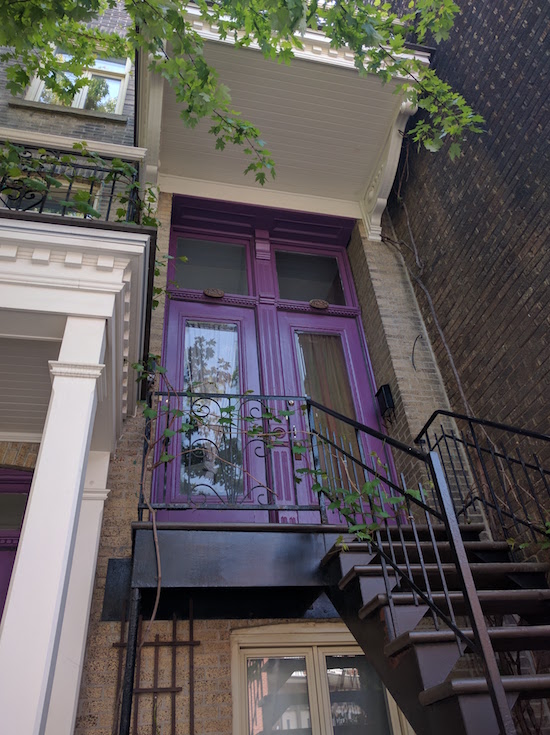
I’m not alone very often, and when I am, I am never lost or aimless. I say this not smugly, but as a mild lamentation. I don’t know that I’d like being alone, lost and aimless to be a pastime, but sometimes such things can lead a person places. This is what I teach in my blogging course, that a blogger needs space to roam, room to wander. And on Friday, I had some of that for myself, as I flew to Montreal to talk about blogging with the Association of English Language Publishers of Quebec. If you know me, you know I rarely leave my couch, so this was a pretty novel opportunity. I flew out from the Island Airport on Friday morning, the whole experience infused with goodness from the get-go—tea, ample leg-room and a good book. A whole hour and a bit in which to read.
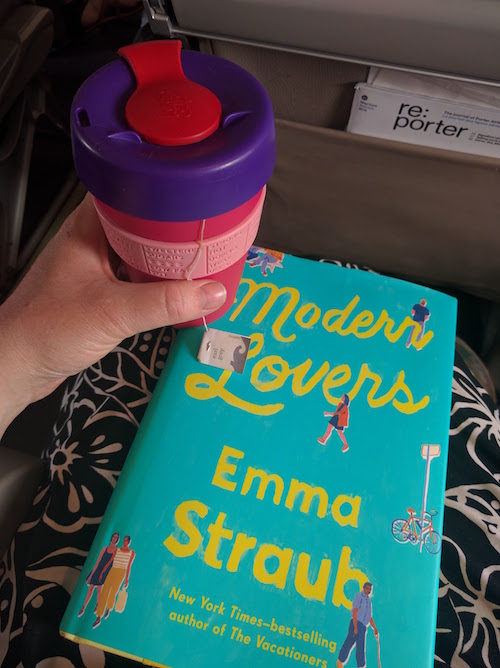
I had a few hours to kill before my event, so I made a plan to explore the Mile End neighbourhood and then make my way through the city to Westmount, where the AELAQ event was being held. My taxi from the airport dropped me off at Librairie Drawn and Quarterly, which immediately landed a space on my Best Bookshops I Have Ever Been To list. A world-famous publisher of amazing graphic novels and comics, they sell their own books, as well as other such books from other publishers, and then kids books, poetry, fiction, cookbooks etc etc making them a perfect general-interest/speciality hybrid. I walked in there and contemplated never leaving.
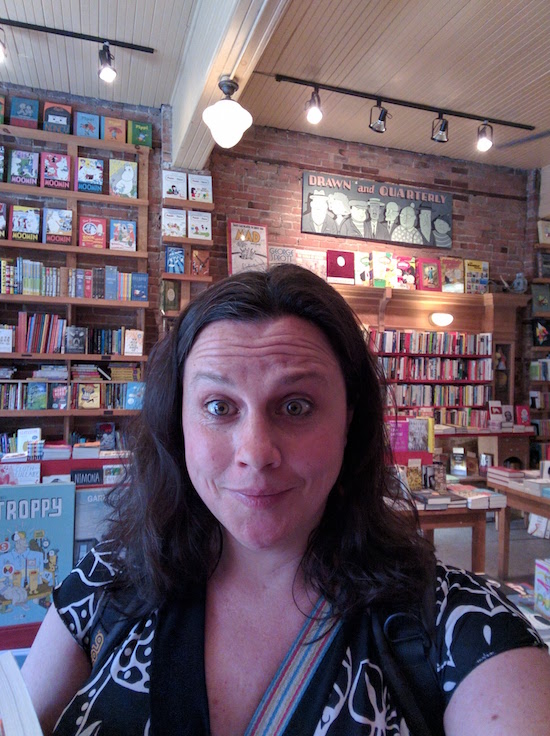
I ended up choosing Rivka Galchen’s Little Labors, which is SO GOOD and I read yesterday. I thought maybe I was through with moms making sense of the new baby books, but no. Looking forward to writing about this one more this week. I also got Photobooth: A Biography, by Meags Fitzgerald, and it’s brilliant. The rest of the books were for my family, and I think I chose very well.
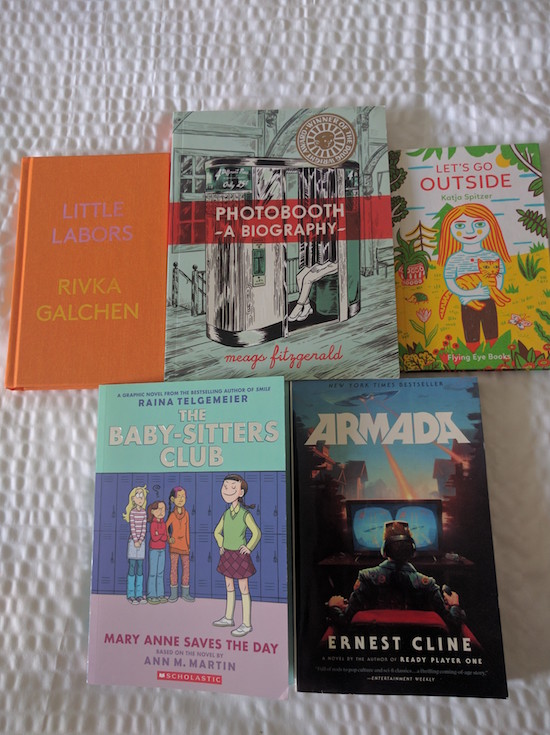
So of course this meant I had a pile of books now to add to all the stuff I had to carry, and although I have never, ever complained about carrying books (the most pleasurable burden I’ve ever had the privilege to experience), my load in general was kind of heavy. It was also 38 degrees outside (no lie: factoring humidity), but no matter, I was on my way. I felt more like Mary Tyler Moore than I usually feel ever, if she’d been making it after all in French Canada whilst carrying a stack of books. I hit up a boulangerie, and got a croissant, and then followed it up with an ice cream cone at Kem CoBa, double scoop because you only live once. And it was so hot that my ice cream was melting faster than I could eat it, and I do appreciate that Montreal was so kind to me in spite of the melted diary stains all over my bag. After that, I added a dozen bagels from Fairmount Bagel to my load, and then set off down Rue Saint-Urban toward my final destination.
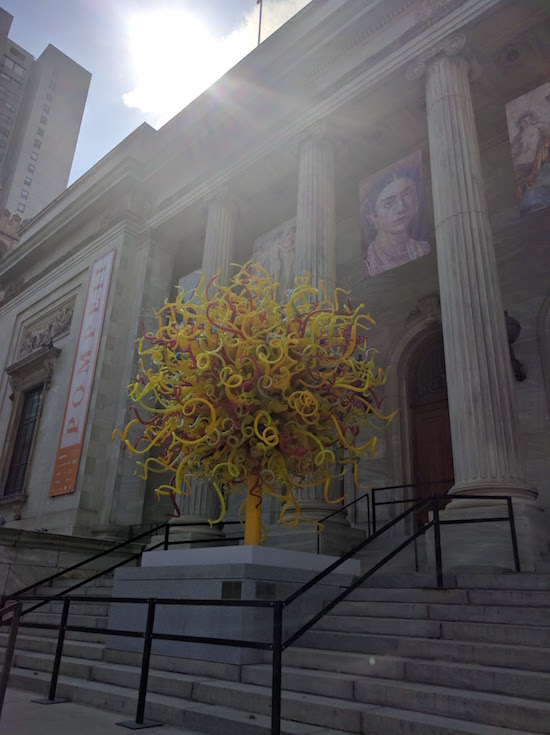
It seemed ridiculously hot, though I think the heat (and the books. and the bagels) were the problem, plus I had to wear a giant shirt because I continue to be allergic to the SUN. I walked through Jewish neighbourhoods, a Portuguese neighbourhood, skirted the park and the mountain, and then arrived downtown where I turned and walked along Rue Sherbrooke, though the McGill Campus and past museums and galleries and there was so much to see..and I was so very hot and did not seem to be arriving at my hotel ever. So I had to stop and steal wi-fi from the Ritz Carlton (whose signal is very strong, stretches all the way across the street) to figure out where I was going. Luckily the right way. I got there eventually, to my hotel with enough time to cool down and change my clothes and iron my dress and be ready for my presentation, which was not far away at the Atwater Library.
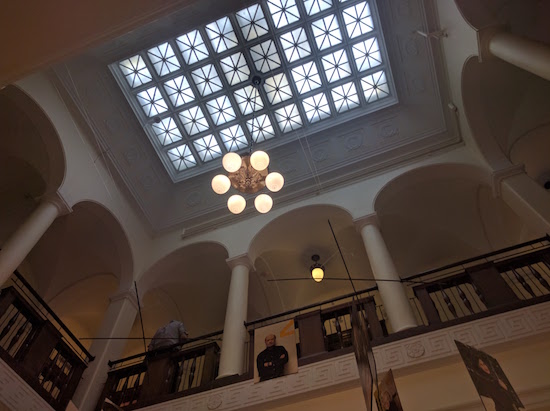
As would be apt for a presentation about how blogging in 2016 is small and focussed, the group that arrived for my presentation was much the same—and they were WONDERFUL. I had such a wonderful time giving my talk, and the group was so receptive, and I was pleased to meet some people again, meet others for the first time, and in particular people whom I’d grown to like already in engaging with them online. It was a terrific experience, and such a privilege to be there. And I was so appreciative to everybody for making me feel so welcome. (And for coming, even though it was by then the middle of a rainstorm and thunder was rumbling outside).
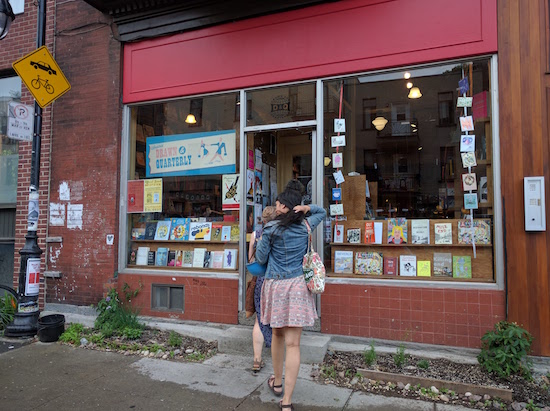
Afterwards, a few of us piled into a taxi and headed back up to Drawn and Quarterly for the Biblioasis launch of books by Alice Petersen and Catherine Laroux. It was a pleasure to be back there and also to have it all set up for an event, and to meet other local writers and readers and get a feel for the Montreal English literary scene. I was so happy to hang out with Saleema Nawaz, who contributed to The M Word and who i’ve long admired, but had really only met fleetingly, and also Elise Moser (who has a new nonfiction children’s title coming out in the fall about “the pioneer of plastics recycling”) and Alice Zorn (whose latest novel, Five Roses, I am so excited to have ahead of me). The readings were great, and then afterwards, we went out for dinner and drank bourbon lemonade and ate fried chicken and nothing annoying or not wonderful had happened to me all day (nearly collapsing from heat stroke notwithstanding). It was nice to be alone in Montreal, particularly in those moments when I actually wasn’t.

Spending the night in a hotel room BY MYSELF (without even sand in the bed. I like holidays, but the bane of my existence is sand in the bed, but there were none in this one) was a ridiculous indulgence, so surrounded was I by good pillows, clean sheets, a comfortable mattress, and many many books. Once I stopped reading I slept soundly, and then spent the morning enjoying a few good hours of quiet and aloneness before it was time to fly back home again.
May 26, 2016
7 Years Today
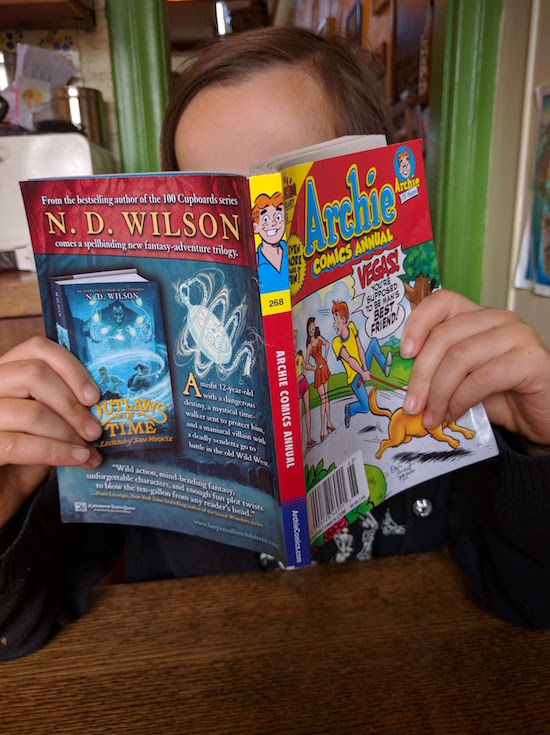
I continue to strongly feel that mothers should be free to write (respectfully) about their children and the lives they share together, though I suppose if my children were unusually vulnerable in some way my feelings about this would be more complicated (and they’re inevitably going to be more complicated anyway at some point in the future). I was talking about this with my friend Diana after we’d seen Vivek Shraya at the Festival of Literary Diversity discussing using her mother in her art and writing, and how she didn’t ask her mother’s permission for this. “Why can’t this license work both ways?” I wondered, though I can anticipate so many possible answers to that question. And Diana made a very good point about the dangers of mothers (it’s always mothers. I don’t suppose fathers get so tied up in knots about writing about their children, or maybe they just don’t, for various reason) writing about their children, which is that the writing might define the child before the child has a chance to define herself.
Although I don’t think I’ve ever done such a thing with Harriet. In writing or in person, I’m strongly resistant to the idea of defining my children (“she’s shy, she’s clever, she’s like this or like that”) because I don’t want such definitions to be the box they feel confined by. A person who is seven years old (or any age for that matter) should it feel absolutely possible to blossom into any kind of person, or not to be a “kind of” person at all. It certainly seems possible to me that this could happen anyway, because of how children are changing all the time. I’ve made a point of writing about both my girls on their birthdays, and from one year to the next, I don’t recognize the curious creature that went before. And that’s why writing it down is so important I think—the value of writing, “This is who she is right now.” Because tomorrow she’ll be someone else entirely, and the only thing that’s consistent is what a pleasure it is to watch her grow.
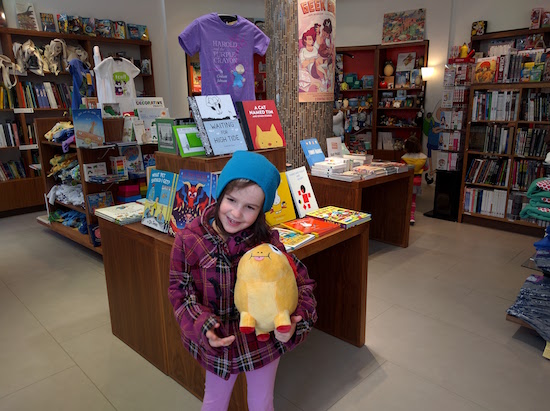
Harriet is seven today, and has been obsessed with hedgehogs ever since Anakana Schofield came to visit and brought her a small stuffed toy of one. She fills pieces of paper with all the hedgehog facts she knows, and likes to quiz us. She likes to open conversations with, “What is your favourite animal?” just so you’ll ask her the same in return. Sometimes it is a bit much. Sometimes she doesn’t care if it is or it isn’t. She loves reading comics and graphic novels, and every trip to the grocery store involves a look at the magazine stands for new Archies. She is a forthright, strong-willed character, who manages to couple such qualities with being pretty easy-going—you can take her anywhere. Her imagination is enormous. She is besotted with her sister and so kind and patient with her in a way I appreciate more than I can ever express. She eats whatever I cook for her, which is new and wonderful, even if it’s beans and spinach fritters. She loves meals out and doing Mad Libs while we wait for our food to arrive. She reads in bed until she falls asleep every night. She is a perfectly average, well-performing student in every way, except that her reading level is over the top. No surprise as she forever has her face in a book. In the past year, she has learned to swim, to skate and ride her two-wheeled scooter, so I no longer fear (mock hysterically, or not so mock) that she has a spatial awareness and balance disorder. She is determined and works very hard to learn new things, which is the most important skill a person can have. She loves her friends at school. She is brave and goes forth when I drop her off at places where she knows nobody, and expect her to get along in a way that I don’t even expect of myself. She pays a lot of attention to the news on the radio, and I don’t always perceive how much she understands. There is a whole side of Harriet I don’t even know at all, depths and fears and fascination, and sometimes a bit comes up to the surface and it floors me because of how familiar and known she is to me otherwise. But as a parent, permitting a child that space to work things out for themselves is really important. She is kind most of the time, and tries to be good, which is as good as it gets. She loves Taylor Swift and wants to be either a rock star or a scientist when she grows up. She loves to sing and dance and put on performances. She likes school and loves her teacher, and is a staunch feminist, which is cool for somebody in grade one. She is old enough to read the Rainbow Fairy books by herself now, so that I don’t have to. (Phew!) She loves Ms Marvel and superheroes and gets really annoyed by lack of female representation in any context. She still reads picture books with us, which I’m so glad about, that she has not deemed herself above childish things yet. She likes cake and ice cream and is so much fun and up for anything, and someone one told me that the ages from 6-11 were the sweet spot of having children, with most development in check and hormones not yet kicking in—and it is true.
Last night our power went out after midnight and Harriet woke up in the pitch black, her nightlight out, and she started calling me in a panic. She’d flipped out of bed and was walking into the wall trying to regain her perspective, and there I found her. I led her out of her room into our front room (and, apropos of nothing, I thought it was so funny when she was discussing the possibility of being rich recently and said, “We would have a really big front room.” Not understanding that the really rich possibly have houses wide enough to accommodate more than one room at the front) where the windows were letting in light, though houses were dark all around us. In the apartment building north of Bloor that we can see from our couch, lit windows were scattered throughout. I pointed them out to help her find her bearings. “Look,” I said. “There’s light up there.” And how she hugged me as we sat there—so solidly and wholeheartedly. It was one of the nicest things that I have ever ever experienced.
The day I found out I was pregnant with Harriet, Stuart took my picture standing before those same windows, positive pregnancy test in hand, and I look ecstatic. And it’s remarkable now think of what was taking shape just then as the picture was being taken, all the things we had no idea about. That everything we were waiting for would be so far beyond our wildest dreams.
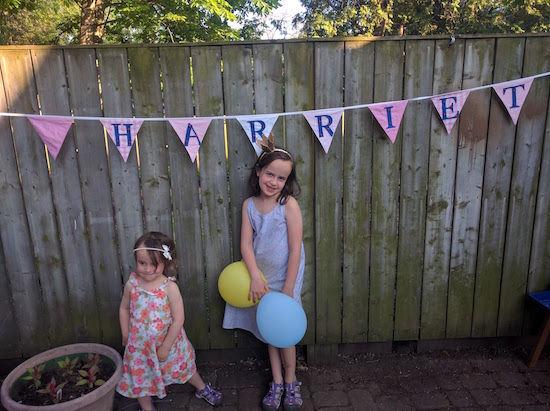
May 25, 2016
Double Teenage, by Joni Murphy
 Okay, I promise you this is the last one, the last time I write a post this week imploring you to pick up a certain book because it’s really fantastic. A list of books to be read can only be so long, I know, but here’s just one more. And I promise you that I actually should be going to bed right now, because it’s eleven o’clock and I’m tired, but first I want to tell you about Double Teenage, by Joni Murphy. A book that I had plenty of reasons to be initially deterred from—my own fatigue/discomfort with books about girls who do drugs and self-harm, a notion that perhaps the book was far too cool for me (as are girls who do drugs and self-harm), and I know nothing about French cinema, plus also its engagement with critical theory. I once made the mistake of embarking upon a Masters degree with no knowledge theoretical frameworks (somehow I missed these during my undergrad, which was mainly survey courses on The Faerie Queen), and it was a terrible disaster, and so a novel that engages with these ideas would normally make me run like the wind…but I didn’t. Because I wanted to read a novel about female friendship. Because the first section of the book is called, “No Country For Young Girls.” Because of the line, “In this world/ there were two kinds of girls,/ Celine and Julie were neither.”
Okay, I promise you this is the last one, the last time I write a post this week imploring you to pick up a certain book because it’s really fantastic. A list of books to be read can only be so long, I know, but here’s just one more. And I promise you that I actually should be going to bed right now, because it’s eleven o’clock and I’m tired, but first I want to tell you about Double Teenage, by Joni Murphy. A book that I had plenty of reasons to be initially deterred from—my own fatigue/discomfort with books about girls who do drugs and self-harm, a notion that perhaps the book was far too cool for me (as are girls who do drugs and self-harm), and I know nothing about French cinema, plus also its engagement with critical theory. I once made the mistake of embarking upon a Masters degree with no knowledge theoretical frameworks (somehow I missed these during my undergrad, which was mainly survey courses on The Faerie Queen), and it was a terrible disaster, and so a novel that engages with these ideas would normally make me run like the wind…but I didn’t. Because I wanted to read a novel about female friendship. Because the first section of the book is called, “No Country For Young Girls.” Because of the line, “In this world/ there were two kinds of girls,/ Celine and Julie were neither.”
Celine and Julie are growing up in New Mexico, a border town. They meet as part of a community theatre production, and Murphy plays with notions of girlhood as a stage/stage. We see both characters performing girlhood, growing up and away from their parents, because witness and victims of violence. They watch television shows (Law and Order and Twin Peaks) and listen to news reports, these ideas along with their own sexual experiences informing their understandings of women’s bodies and who they belong to and what they are to be used for. After high school gradation and a few years at a local college, both women depart for further afield, Julie to Vancouver to Celine to Chicago. And here they fall out of touch, and yet their stories remain connected, however obliquely. The narrative engages with missing and murdered women along the border in Mexico, and with the Robert Pickton case in Vancouver:
“What are the chances that the girls would live so close to two sites of the slow-motion mass murder of girls? / What are the chances?/ Good I guess.”
The last line of the book: “This is a spell for getting out of girlhood alive.” Murphy showing that the threat is from without just as much as it’s from within, just as much as society conspires toward the latter, how many people profit by it, when a girl’s body is turned into something to be consumed. That perhaps there’s really no distinction between the two.
“This is a world with syringes filled with blue liquid and faux fur-lined handcuffs, night-vision goggles and Spanish fly aphrodisiac, wallet photos of children in pink ruffles and velvet paintings of moonlit mountains. This is a world with things we have made.”
I’m nearly an exact contemporary of Celine and Julie, of Murphy even, and so I related to this story on a very personal, visceral level. (The part about Julie and her mother driving from Washington to New Mexico listening to Graceland: “They would be able to sing along with Graceland for the rest of their lives.” Later Celine contemplates heartbreak: “Everyone can see you’re blown apart.”)
Columbine, the protests in Quebec City in 2001, the day Saddam Hussein was hanged: our sorry cultural touchstones.
It’s heavy, but it’s not. I read this book all day on Sunday, a few hours in the afternoon in my hammock. I devoured it, and loved the shape of the project—that this is a novel gesturing outwards, pointing to the world, using the world and its threads to build something new, offering structure, frameworks, where we hadn’t seen such a thing before. Daring to state that girlhood is significant, even if it’s a stage, and even if it’s a stage. I loved the poetry of Murphy’s prose, the power of her language. The power of the book full stop—it’s both the story of my life and also unlike anything I’ve ever read before.
May 24, 2016
The Turner House, by Angela Flournoy
 Would you agree that the very best worst problem in the world to have is the one where you keep reading stunning book after stunning book, but absolutely don’t have the time to write about them? Or especially to write about them with the care and attention each individual book deserves? Or when you read a book with the explicit intention of not actually writing about it, that’s going to be all for pleasure, because this book came out a year ago anyway and was a finalist for a National Book Award and so surely doesn’t need you to blow its horn. And yet you have to? Because to love a book is to talk about a book, and I want everybody to know about this one.
Would you agree that the very best worst problem in the world to have is the one where you keep reading stunning book after stunning book, but absolutely don’t have the time to write about them? Or especially to write about them with the care and attention each individual book deserves? Or when you read a book with the explicit intention of not actually writing about it, that’s going to be all for pleasure, because this book came out a year ago anyway and was a finalist for a National Book Award and so surely doesn’t need you to blow its horn. And yet you have to? Because to love a book is to talk about a book, and I want everybody to know about this one.
The Turner House, by Angela Flournoy, which I bought after reading Doree Shafrir’s piece at Buzzfeed, Why America is Ready for Novelist Angela Flournoy. And I had a feeling that I was, ready that is. The piece begins: ‘I’m driving through Detroit in a rented Ford sedan with the author Angela Flournoy, and it’s hard not to think that Google Maps is deliberately trying to get us to avoid the city’s ghosts. “It keeps wanting to — I’m just going to say, avoid things. Because this is a city that always wants to put you on a freeway.” ‘ And it was such a fantastic premise for an article, the disembodied GPS voice always threatening to throw the piece off-route, and Detroit to me is such a compelling setting for a story. I have this habit while reading books set in Detroit of doing Google street view searches for places mentioned in the text, and what I find on those streets is always stranger than my imagination—blocks of empty lots, overgrown sidewalks, here and there scattered a house, sometimes upkept, but often abandoned. Burned out shells. It seems strange that this place is real, streets on which actual people live.
Although Yarrow Street, portrayed in Flournoy’s novel, is fictional. And the world that she creates in her novel is one that seems familiar to me. In the Buzzfeed profile, she explains that she consciously didn’t draw attention to the blight in her book, to the things that would seem familiar and unremarkable to anybody who lives in the neighbourhood she writes about. “So imagine if you lived here every day of your life—it becomes part of the landscape. So I try to just be accurate in characterization. And that’s where the challenge is. Because I want other people to see this place like they’ve never seen it. I’m gonna point out the things that are interesting, but I also don’t want to focus too long on things that are not the things that you focus on if you live here.”
Yarrow Street is on the decline. Most of the old neighbours have died and departed, and the Viola Turner, the family matriarch, has gone to stay with in the suburbs with her son Cha-Cha, the eldest of thirteen. And it’s not supposed that she’ll be returning home, although nobody wants to admit it, and in grappling with this idea and the controversial question of just what to do with the family home once their mother goes—the bank has disclosed that it’s worth about four thousand dollars—all the while recovering from an accident that has left him weakened physically as well as psychologically, Cha-Cha is brought close to a breakdown regarding an experience from decades before, a curious encounter with an apparent ghost who tried to kill him. An experience that has haunted him ever since, but in raising the matter with his church-going wife, his dying mother, and his ever-feuding brothers and sisters, Cha-Cha seems to only make things worse. Meanwhile, unbeknownst to all of them, the youngest sister is a gambling addict who’s become homeless, and squatting in the house on Yarrow Street, meanwhile their brother Troy is hatching a plan to shortsell and buy the place out from all of them. And all the time, there’s an undercurrent, the story of their parents at the very beginning, a story none of the children knew, but has which has haunted all of them in ways they only just perceive. How much is legacy? How much is destiny? And how hard is it to disentangle from all of that and build an actual life for one’s self?
The Turner House deserves all its critical acclaim, and then some. Like Google street view, it’s the kind of world that you can lose yourself in, and well forget about the other one. If you’re on the lookout for a Great American Novel, I can’t think you’d do any better than starting right here.
May 23, 2016
The Most Heartless Town in Canada, by Elaine McCluskey
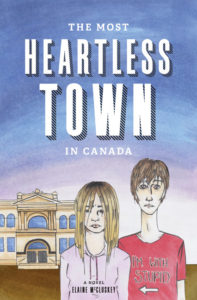 I’ve been a huge fan of Elaine McCluskey since her short story collection, Valery The Great. I love her merciless humour, the way she packs a sentence, her singular point of view which casts the ordinary in such an extraordinary light, and I love that her unsparing perspective is thoroughly laced with hope and kindness. All these things are on show in her latest novel, The Most Heartless Town in Canada, which begins with a Diane Arbus-inspired image and eight bald eagle carcasses. The town of Myrtle, Nova Scotia, has never been in the national press until this photo which goes out over the wires, and suddenly the boy and girl depicted find themselves as infamous as their town is. The story of the town involves its poultry plant and the bald eagles who’d started feasting on entrails left by plant workers, gathering a popular following of their own before all being brutally slaughtered. The story of the boy and girl is even more complicated that that, and involves a pitiful swim team with big dreams, their overenthusiastic coach, her dodgy boyfriend, and a get-rich-quick scheme. The girl is the photo is Rita Van Loon, an unremarkable swimmer, middling member of the Myrtle Otters. The boy is Hubert Hansen, who has just moved to Myrtle with his mother after the death of his father, and who wanders to the streets of town with his dog and perhaps sees more than anybody. Together, Hubert and Rita tell the real story behind the headlines and think-pieces, disturbing the reader’s notion of small-town stereotypes and the urban/rural divide. The most wonderful thing about McCluskey (and what makes her so funny) are the people she creates, characters who conform to type enough to be familiar but then surprise you just like real people do. Although the problem with this is that sometimes these people forget they’re in a novel and start doing their own thing, which is to say that The Most Heartless Town in Canada can lack cohesion. But that doesn’t undermine the goodness of this book, the delight I took in it. McCluskey’s writing is so good, her characters so richly drawn, and the payoff so great—in heart and humour both—that you’ll be happy to follow these sentences down any avenue, and all over town.
I’ve been a huge fan of Elaine McCluskey since her short story collection, Valery The Great. I love her merciless humour, the way she packs a sentence, her singular point of view which casts the ordinary in such an extraordinary light, and I love that her unsparing perspective is thoroughly laced with hope and kindness. All these things are on show in her latest novel, The Most Heartless Town in Canada, which begins with a Diane Arbus-inspired image and eight bald eagle carcasses. The town of Myrtle, Nova Scotia, has never been in the national press until this photo which goes out over the wires, and suddenly the boy and girl depicted find themselves as infamous as their town is. The story of the town involves its poultry plant and the bald eagles who’d started feasting on entrails left by plant workers, gathering a popular following of their own before all being brutally slaughtered. The story of the boy and girl is even more complicated that that, and involves a pitiful swim team with big dreams, their overenthusiastic coach, her dodgy boyfriend, and a get-rich-quick scheme. The girl is the photo is Rita Van Loon, an unremarkable swimmer, middling member of the Myrtle Otters. The boy is Hubert Hansen, who has just moved to Myrtle with his mother after the death of his father, and who wanders to the streets of town with his dog and perhaps sees more than anybody. Together, Hubert and Rita tell the real story behind the headlines and think-pieces, disturbing the reader’s notion of small-town stereotypes and the urban/rural divide. The most wonderful thing about McCluskey (and what makes her so funny) are the people she creates, characters who conform to type enough to be familiar but then surprise you just like real people do. Although the problem with this is that sometimes these people forget they’re in a novel and start doing their own thing, which is to say that The Most Heartless Town in Canada can lack cohesion. But that doesn’t undermine the goodness of this book, the delight I took in it. McCluskey’s writing is so good, her characters so richly drawn, and the payoff so great—in heart and humour both—that you’ll be happy to follow these sentences down any avenue, and all over town.
May 22, 2016
Montreal!

I’ll be in Montreal on Friday talking about literary blogs in 2016 (“now that the bubble has burst…”) with the Association of English-language Publishers of Quebec. I would love to see you there!
May 22, 2016
I slept all night
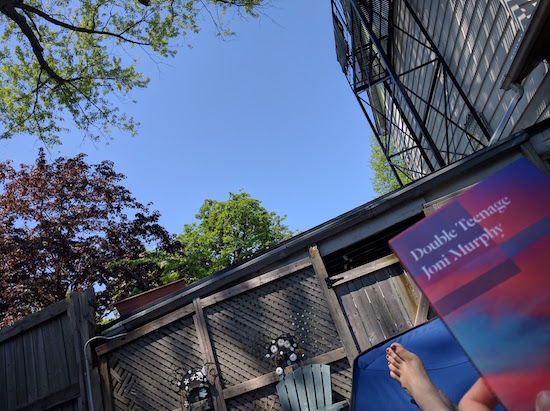
I slept all night last night. This is beginning to be kind of unremarkable, since I don’t know when, and it’s not always the case, but more and more it is. Which means something in particular right now, because I’m thinking back to the May holiday weekend last year, which was dreadful, and I wasn’t sure how it wasn’t always going to be that way. (That was the weekend where we had to send our babysitter home because Iris wouldn’t go to sleep, and taking 2+ hours to fall asleep in the evening would proceed to wake up at midnight and every few hours thereafter, and I was so tired and sad and felt enslaved by it all. That was the weekend I finally stopped breastfeeding and we left her to cry until she learned to fall asleep on her own, because I just couldn’t stand it anymore). And while it’s true that me daring to write this down here means that Iris will make up screaming at 4:30am tonight, it’s just nice to affirm that some things do get better.
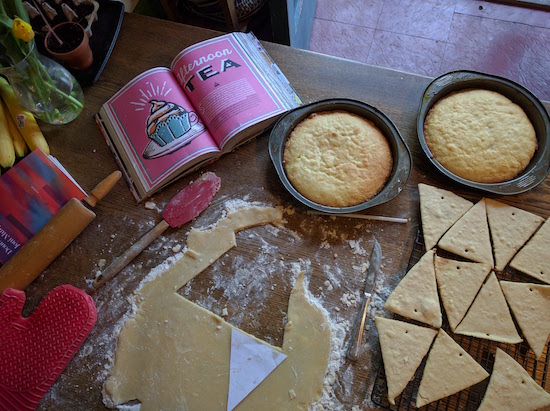
We have had a nice weekend—we went to see my parents yesterday and drove home into the most stunning sunset and nobody cried or threw up because we’d gotten all that out of our system on the journey there that morning. Today we got up early (isn’t it funny what can happen when you sleep) and tidied up our backyard and deck for summer, planting flowers in our pots and getting them up all lined up on the fire-escape. Iris went down for her nap (because yes, Iris naps again—we found out that we like her so much better when she does) and I spent the afternoon drinking ice-tea in my hammock in the sunshine. And then got to work preparing for our party tomorrow—Victoria sponge cake and edible bunting (I KNOW!). It’s Harriet’s birthday party, which has a Queen Victoria tea party theme. There will be jam tarts and tiny sandwiches, and we will be making tea blends and decorating mugs. And the party launches our month of celebrations: her actual party on Thursday, Iris’s birthday not long after, and our wedding anniversary, and Father’s Day, and my birthday, and also the birthdays of both our moms. June is full to bursting. And goes by oh so fast.
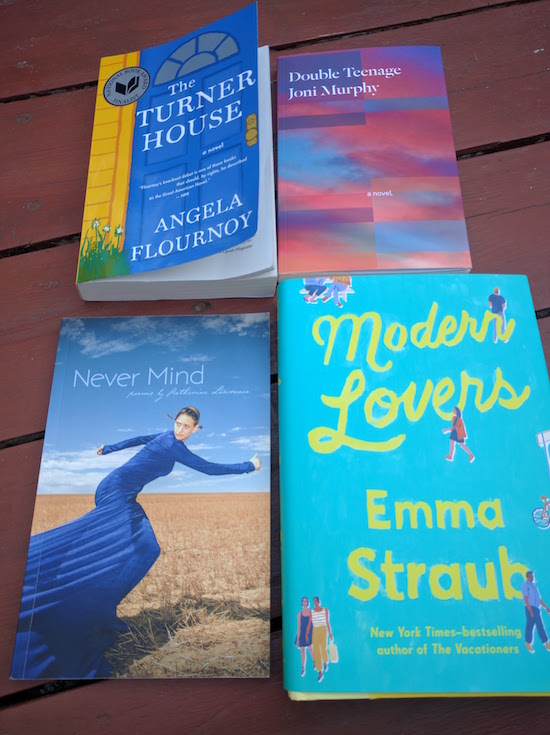
I’ve been reading the most fantastic books this weekend—The Turner House, by Angela Flournoy, was a stunner of a debut novel, and one of the best books I’ve read in ages. I remember how good it felt to read The Corrections the first time all those years ago, back before hating Jonathan Franzen became an international pastime (who I’ve resented ever since Freedom), and The Turner House was kind of like that. The Detroit setting is so compelling, and the novel is so much in its reach (as any novel about a family with 13 siblings would be) and I loved it. I wanted to buy the book as soon as I read Doree Shafrir’s profile, “Why American is Ready for Novelist Angela Flournoy” and the novel did not disappoint. (Incidentally, how much richer would literature be if everyone wrote as wonderfully about books as Shafrir does here?)
I’ve spent today reading Double Teenage, by Joni Murphy, which I was initially concerned I wasn’t cool enough to appreciate, but it’s painful and wonderful (and is also the reason we’ve been listening to Graceland all day). The Katherine Lawrence book, Never Mind, is for our book club meeting next month. And yesterday I bought Modern Lovers, by Emma Straub, whose The Vacationers I read over the July 1 long weekend two years ago as I was embarking upon the first few pages of the first draft of Mitzi Bytes, and gave me the idea of the literary tone I aspired to. So I find myself nostalgic again as I contemplate her latest title while in the very early stages of a new writing project of my own. I kind of want to start reading it right away, but I also am tempted to save it, to look forward to it for a little longer.
May 20, 2016
The Fox and the Star, by Coralie Bickford-Smith
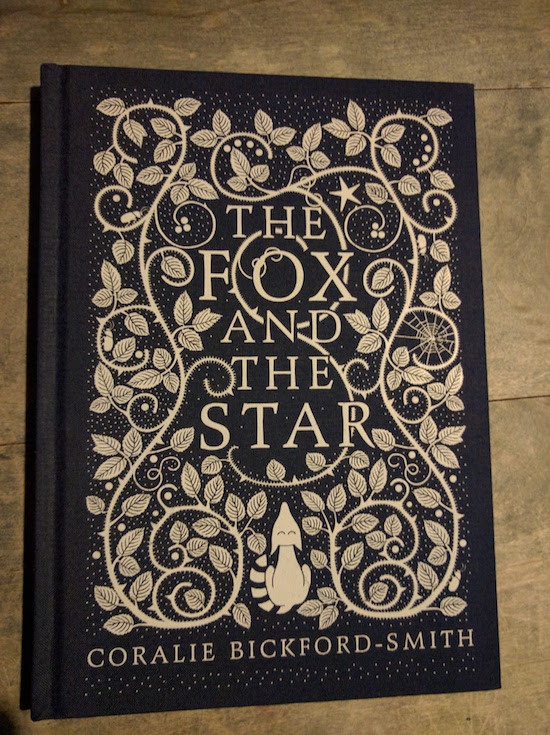
So obviously we didn’t end up buying The Dead Bird by Margaret Wise Brown, and got The Fox and the Star, by Coralie Bickford-Smith, which I can’t say is a hardship. And really, that this book is by Coralie Bickford-Smith (world-renowned book designer) tells you everything you need to know about The Fox and the Star: visually, the book is stunning. But does being a book designer necessarily mean that a person can write a book? In the case of Bickford-Smith, it does, in particular because design is so integral to what makes a good picture book work. I’m thinking of an author/illustrator like Virginia Lee-Burton who, like Bickford-Smith, knows the limits of the page and uses those limits and the liminal spaces. There is no single part of the book that doesn’t matter, that doesn’t have attention to it.
Can in point? Endpapers.
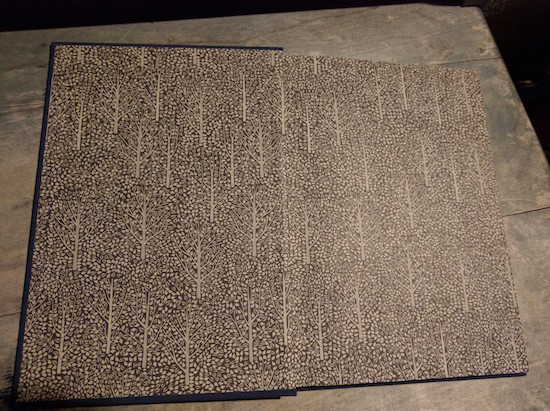
The Fox and the Star is the story of a fox who is small beneath the trees and the sky, but takes comfort in the constancy of a star above him.

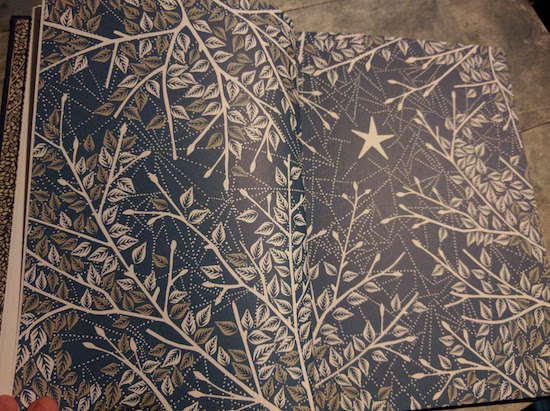
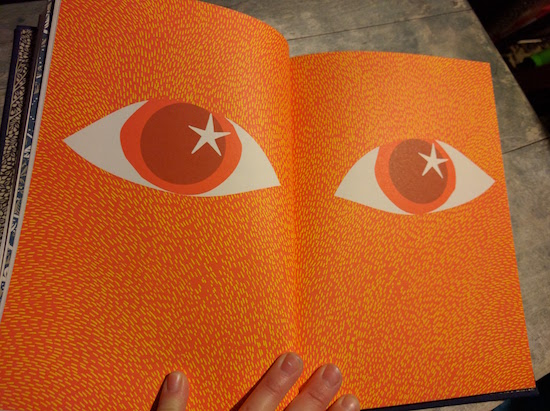
The forest is not the the place for constancy though, and one night the fox looks above him and the star isn’t there anymore.
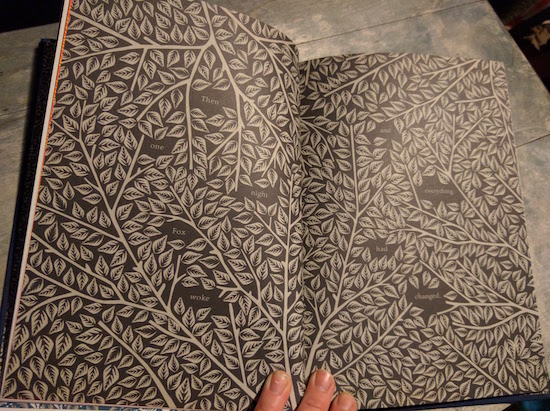
Bickford-Smith shows the life and movement of the forests, above ground, on the ground and underneath it. Her scurrying insects are amazing, as our the rabbits created of white space, and the ferns, and the orange of the leaves as the seasons change, and how she integrates the text into her illustrations. And gradually we begin to understand what has happened to the star.
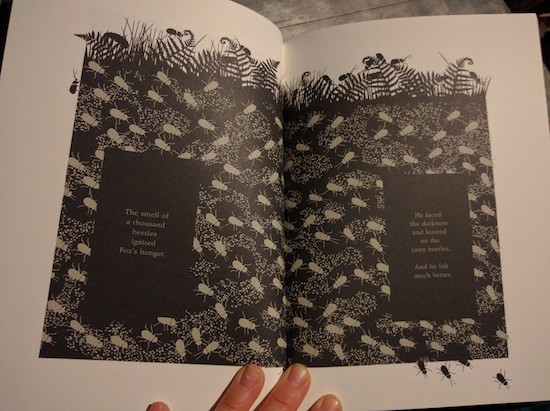
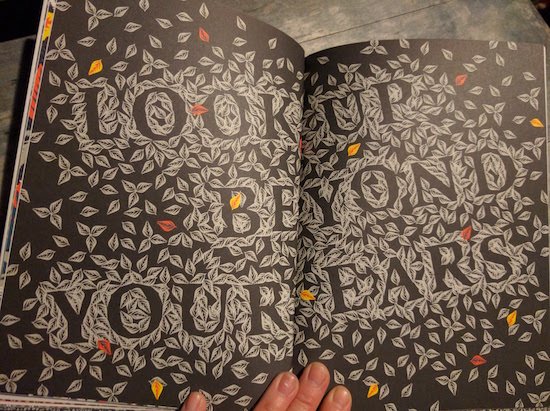
And as the leaves fall, the fox looks up to find the star again, high up in a sky that’s full of them: “Fox could not believe there were so many stars. His heart was full of happiness.”
This book is exquisite.
May 19, 2016
The Suitcase

On Friday night we watched “The Suitcase”, which might be my very favourite episode of Mad Men ever (along with “The Wheel”, “Shut the Door, Have a Seat,” “Meditations in an Emergency,” and and and…). Although it’s significant to note that it’s taken us three months to get to “The Suitcase” after (re)watching the first three seasons at almost an episode daily throughout January and February. Part of this is circumstantial: we went away for the first week in March, we spent some time watching other things (including a Mad Men-inspired viewing of The Apartment, which was so wonderful), and I also stopped watching TV daily because I wanted time to read. But part of it is also the nature of Season 4, which was a turning point for the series. It was always Don Draper’s domestic situation that interested me most about the show—the contradiction of his character trying to fit the mould of husband and father—and by Season 4 that situation has disintegrated. (He eventually gets together with Megan, but their relationship never mattered to me as much as Don and Betty’s did, partly because it was hard to believe it really mattered to either of them. The stakes were never high enough.) Season 4 is also painful to watch in places—Don Draper is falling to pieces. It makes me think about the freedom Don is promised by the end of his marriage, which sounds like what he was sold as a child in “The Hobo Code” about being able to sleep so much better without the chains of a mortgage, etc. But it doesn’t turn out to be so freeing after all.
But with “The Suitcase,” Season 4 finally starts to get it together, just like Don does. It’s a pivotal episode for Peggy as well, who finally breaks up with her mediocre boyfriend and begins to see herself on equal terms with her boss. (Remember back in Season 2 where she calls him “Don” for the first time? It’s like that.) We see the depth of Don’s descent in this episode too, which we’ve only glimpsed in previous ones. He’s gross, and ugly, and mean. But he also makes himself known here in a way he doesn’t very often. At no point in this episode did I have to write, “What is Don Draper thinking?” in my notes is what I mean, and I always have to write that. When Peggy suggests that Anna is not the only person in the world who knows Don, she’s not wrong. She doesn’t know the details, but she gets him. She knows what he’s thinking, and she takes her knowledge to apply to her own situation to get where she’s going. But in this situation also, she can use it to be a friend. (And neither of these characters has very many of these.)
The episode is also really funny, delivering that legendary scene in which Duck Phillips tries to take a shit in Roger’s chair. “I killed 17 men at Okinawa.” Fantastic bathroom scenes too—Megan and Peggy, and then a heavily-pregnant Trudy Campbell and assures Peggy that she’s still young. (Also, “You’re witty…) And then the look on Pete’s face when he sees Peggy and Trudy together. They are a fascinating triumvirate. We find out Peggy’s resentment at Don taking all the credit for the GloCoat ad: “You never say thank you.” “That’s what the money is for.” They go out to eat and Don asks Peggy, “What’s the most exciting thing about a suitcase?” “Going somewhere,” she answers. They talk about how you know when you’ve had a good idea. Coming back to the question of wanting and desire, which has been a fixation of the series from the start. “I know what I’m supposed to want, but it never feels right,” says Peggy, articulating something that Don has never been able to do, but certainly understands.
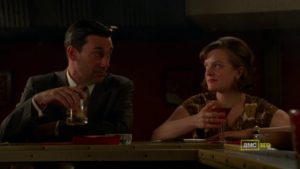 They talk about how they both saw their fathers die. Don reveals that he never knew his mother. He tells Peggy that she’ll find someone, “You’re cute as hell,” and she tells him that everybody thinks she got her position by sleeping with him. He says that he didn’t sleep with her because she was unattractive, but because he has rules for work. She reminds him that he’s broken those rules. “You don’t want to start giving me morality lessons,” he tells her. “People do things.” And then he asks her about her baby—do you know how strange this is? For Don to be curious about anybody’s inner life? (I wonder if there is a connection between the mother he lost and the baby Peggy gave away.) “Do you think about it?” he asks her. She tells him, “It comes out of nowhere.”
They talk about how they both saw their fathers die. Don reveals that he never knew his mother. He tells Peggy that she’ll find someone, “You’re cute as hell,” and she tells him that everybody thinks she got her position by sleeping with him. He says that he didn’t sleep with her because she was unattractive, but because he has rules for work. She reminds him that he’s broken those rules. “You don’t want to start giving me morality lessons,” he tells her. “People do things.” And then he asks her about her baby—do you know how strange this is? For Don to be curious about anybody’s inner life? (I wonder if there is a connection between the mother he lost and the baby Peggy gave away.) “Do you think about it?” he asks her. She tells him, “It comes out of nowhere.”
And then when Don calls Stephanie and gets the news that Anna has died, and he falls apart, and they sleep together, but only in the literal sense. And then she returns to his office later that morning and he’s all fresh as though nothing has happened, and she’s gone to sleep on her office couch, and we’re all ready to see him punish her for having witnessed his vulnerability—it’s certainly happened before. But he doesn’t. And how he how he clutches her hand. All this anticipating the wonderful episode in Season Six (or Seven?) when they dance together. And also referring back to when she stroked his hand provocatively in the first episode of the series and he rejected her (and I suppose also how he takes Betty’s hand when she tells him she is pregnant at the end of Season 2—interesting how a man supposedly so fluent in ideas is most honest with a wordless gesture).
When she leaves the room, the door is left open. And Don Draper is ready to start climbing again.
May 18, 2016
Mini Reviews: He Wants and Middenrammers
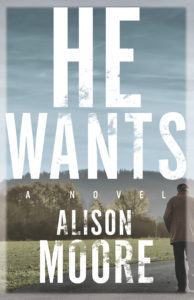 Alison Moore follows up her Booker-shortlisted The Lighthouse with He Wants, a novel that is an exercise in withholding and revelation. As the title suggests, this is a book about yearning. Lewis Sullivan has lived a quiet life and cannot articulate just what he longs for to either himself or to his reader, although the reader going back through the seemingly quiet text will notice that all the signs are there, in previously invisible flashing lights, even, and it’s quite remarkable that a “quiet” text can be such a minefield upon rereading. The narrative follows Lewis over the course of a single day whose pattern is disturbed by the arrival of a stranger in town…except that he’s not a stranger at all, but Lewis’s former schoolmate. And while the novel’s web became too tangled by the end—story threads about Lewis’s daughter and also a local thug distracted from the central story, too much coincidence—the climax is perfectly, subtly performed, and beautifully written. DH Lawrence fans in particular should take note. Plus, Rachel Cusk loved it.
Alison Moore follows up her Booker-shortlisted The Lighthouse with He Wants, a novel that is an exercise in withholding and revelation. As the title suggests, this is a book about yearning. Lewis Sullivan has lived a quiet life and cannot articulate just what he longs for to either himself or to his reader, although the reader going back through the seemingly quiet text will notice that all the signs are there, in previously invisible flashing lights, even, and it’s quite remarkable that a “quiet” text can be such a minefield upon rereading. The narrative follows Lewis over the course of a single day whose pattern is disturbed by the arrival of a stranger in town…except that he’s not a stranger at all, but Lewis’s former schoolmate. And while the novel’s web became too tangled by the end—story threads about Lewis’s daughter and also a local thug distracted from the central story, too much coincidence—the climax is perfectly, subtly performed, and beautifully written. DH Lawrence fans in particular should take note. Plus, Rachel Cusk loved it.
**
 John Bart’s debut novel, The Middenrammers, suffers from being a novel with a political agenda, which works in places to undermine the impact of the characters on the page who are not necessarily enlivened by their own will. It’s the story of a young doctor who arrives in a Yorkshire town to practice at the town’s maternity hospital in 1970, and finds himself up against forces working to restrict women’s access to contraception and abortion. Things are a little too black and white—the evil-doers in this book are so totally evil but—as Chimamanda Ngozi Adichie wrote in her novel, Americanah—“like life is always fucking subtle.” And whenever I was feeling frustrated by the lack of subtlety, Bart would go and blow me away with a stunning scene, like the one in which the doctor has his arm stuck inside a woman’s vagina to keep the cord from prolapsing, and must move through the entire hospital in this awkward manner to get her to surgery. And he portrays the devastating impact of restricting women’s reproductive freedom, and shows too how such restrictions are part of systemic project of oppression of women and the poor. Despite my few reservations, I really enjoyed this fast paced novel, read it in a day, and think it would appeal to anyone who’s been a fan of Call The Midwife.
John Bart’s debut novel, The Middenrammers, suffers from being a novel with a political agenda, which works in places to undermine the impact of the characters on the page who are not necessarily enlivened by their own will. It’s the story of a young doctor who arrives in a Yorkshire town to practice at the town’s maternity hospital in 1970, and finds himself up against forces working to restrict women’s access to contraception and abortion. Things are a little too black and white—the evil-doers in this book are so totally evil but—as Chimamanda Ngozi Adichie wrote in her novel, Americanah—“like life is always fucking subtle.” And whenever I was feeling frustrated by the lack of subtlety, Bart would go and blow me away with a stunning scene, like the one in which the doctor has his arm stuck inside a woman’s vagina to keep the cord from prolapsing, and must move through the entire hospital in this awkward manner to get her to surgery. And he portrays the devastating impact of restricting women’s reproductive freedom, and shows too how such restrictions are part of systemic project of oppression of women and the poor. Despite my few reservations, I really enjoyed this fast paced novel, read it in a day, and think it would appeal to anyone who’s been a fan of Call The Midwife.





